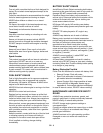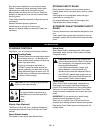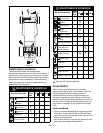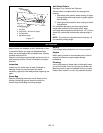
GB - 16
Battery Electrolyte First Aid
Follow First Aid directions for contact with battery fluid.
• External Contact: Flush with water.
• Eyes: Flush with water for at least 15 minutes and get
medical attention immediately!
• Internal Contact: Drink large quantities of water.
Follow with Milk of Magnesia, beaten egg or
vegetable oil. Get medical attention immediately!
IMPORTANT: In case of internal contact, DO NOT
induce vomiting!
Cleaning Terminals
Keep battery and its terminals clean. Inspect monthly
to maintain best performance.
Remove corrosion from battery terminals and cable
connections with a wire brush, then wash with a weak
baking soda solution.
After cleaning, apply a thin coat of grease or petroleum
jelly to terminals and cable ends to retard corrosion.
Electrolyte Level
Every 25 hours or each week check electrolyte level of
each cell by removing caps one at a time. The
electrolyte level should be at level indicator. Use
distilled water to fill each cell if needed.
IMPORTANT: When distilled water is added to battery
during freezing weather, it must be charged to mix
water with electrolyte or water will remain at top and
freeze.
Charging
ALWAYS follow information provided on battery by
battery manufacturer. Contact battery manufacturer for
extensive instructions to charge battery.
Place unit on a level surface, shut off engine and open
battery compartment to gain access to battery.
1. Disconnect negative (–) cable first, then positive
(+) cable.
2. Loosen strap and remove battery.
3. Place Battery on bench or other well ventilated
place where electrolyte spill will not create
damage.
4. Remove caps and fill each cell to level indicated
with electrolyte at 1.265±.05 specific gravity and
80°F (27°C).
5. Let battery stand for one half hour.
6. Check electrolyte level and add more if necessary.
7. Connect positive (+) lead of charger to positive (+)
terminal, and negative (–) lead to negative (–)
terminal.
8. Charge the battery at two and a half amps for ten
hours or until all cells are gassing freely and the
specific gravity is constant over three 30 minute
intervals.
9. Immediately after charging, check electrolyte level.
If low, add distilled water to bring cell up to required
level.
10. Replace caps finger tight, wash off and dry battery.
11. Reinstall battery into unit and connect positive (+)
cable first, then negative (–) cable.
Battery Charger
Under normal conditions the engine alternator will have
no problem keeping battery charged. When unit has
set for an extended period of time without operation
and the battery has been completely discharged, a
battery charger will be required for recharging.
Before using a charger, an attempt can be made to
recharge the battery using the engine alternator by
jump starting the unit and allowing the to engine run.
JUMP STARTING
Jump starting, battery charging or replacement is
required when the starter motor will not crank the
engine.
To jump start battery:
1. Ensure battery is not frozen. If the fluid is frozen,
remove battery from unit and allow it to thaw
before charging.
2. The unit used for jump starting should have a 12
volt battery with at least 500 cold cranking
amperes, and a negatively grounded system.
WARNING: EXPLOSIVE GASES from
battery can cause death or serious injury.
ALWAYS keep open flames, sparks, or
smoking materials away from batteries.
POISONOUS BATTERY FLUID contains
sulfuric acid and its contact with skin, eyes or
clothing can cause severe chemical burns.
ALWAYS wear safety glasses and protective
gear near battery.
DO NOT TIP any battery beyond 45° angle in
any direction.
ALWAYS KEEP BATTERIES OUT OF REACH
of children.
WARNING: Battery posts, terminals and
related accessories contain lead and lead
compounds, chemicals known to the State of
California to cause cancer and reproductive
harm. Wash hands after handling.
CAUTION: FROZEN BATTERIES CAN
EXPLODE and result in death or serious
injury.
DO NOT charge a frozen battery. Let the
battery thaw out before putting on a charger.


















